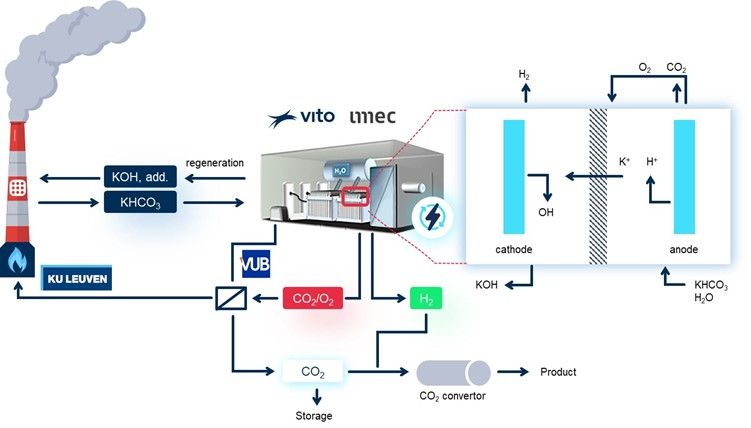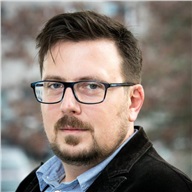For CO2-intensive industries, so-called CCU(S), which stands for 'carbon capture and utilisation (and storage)', can provide relief to become carbon-neutral. While reuse, capture and purification of CO2 are usually considered separate concepts, they can also be combined in an integrated solution. This would require a physical integration of technology covering all these steps. VITO has developed two different concepts for this, which moreover fit in nicely with Flemish industrial needs. The ambition is now to quickly scale up both concepts to demonstration level.
VITO is well skilled in researching innovative technologies and concepts to extract CO2 from flue gases or from the air, and to subsequently treat the greenhouse gas for reuse. Especially in recent years, this research has been booming. The fact that VITO is currently involved in more than ten different projects on CCU is an illustration of this.
These CCU projects vary widely in terms of content. For instance, some focus solely on the electrochemical conversion of CO2 into synthetic fuels and base chemicals, while others also use innovative integrated concepts to make CO2 capture more efficient. What binds these projects is that they are still at lab or pilot scale, making them relatively far from market realisation. Also, the projects often involve only a specific component of CCS or CCU technology.
HELPING CO2-INTENSIVE INDUSTRY BECOME MORE SUSTAINABLE
However, VITO now wants to change that. Two concrete integrated technology concepts, which can involve both CCU and CCS, will be scaled up from lab level to demonstration level. 'We want to demonstrate that our technology is ready to be picked up by industry so that it can work with it to make its processes more sustainable,' says VITO's Metin Bulut. The integrated aspect can help win industry over, for example, both concepts largely encompass the technological value chain of CCU, from the source of the CO2 (flue gases or air) to its reuse as a raw material for products.
The integrated approach also has an economic advantage. Bulut: "This gives industry access to opportune applications of the technology, with an interesting cost tag. For VITO, then, scaling up the two concept technologies is a great opportunity to valorise its patent portfolio. 'But above all, with this we support the development of CCU(S) in Flanders, and thus the sustainability of CO2-intensive industry.' This is ultimately also the intention of the Flemish Moonshot programme, from which the VITO research is partly supported.
In the first concept, the integration of CO2 capture with its processing is done by using a simple alkaline (basic) solution. This not only absorbs the CO2 but also acts as a medium for an electrolysis process in which the CO2 molecules, in the form of bicarbonate, are converted - preferably, of course, with electric current coming from low-carbon sources. This carbon source can be used to create useful basic chemicals such as methanol, but just as easily synthetic fuels. A useful feature of the process is that it can be quickly turned on and off. It is, in short, a nice example of flexible CCU.
The technology behind this concept, named 'integrated alkaline capture and conversion', was developed entirely by VITO - it also holds a patent on it. The concept is particularly promising because CO2 capture would be a lot cheaper than with today's available technologies. 'For capture from the air, so-called direct air capture or DAC, the promised picture looks promising,' says Bulut. Thereby, CO2 capture with the VITO technology would cost a maximum of 70 to 90 euros per tonne, whereas today it would cost more than 200 euros.
CO2 capture and conversion also come together in the second concept, although this concept primarily lends itself to isolating the captured CO2 - possibly temporarily so that the greenhouse gas can be stored or converted and reused elsewhere. The technology is in part similar to that of the first concept: it too uses a bicarbonate solution and electrolysis. The difference is that hydrogen gas is also produced (a very useful gas) as well as a pure mixture of CO2 and oxygen gas. 'This mixture can then be separated, leaving us with three gases,' Bulut continues. The oxygen can be used in combustion processes, which primarily consume less fuel and produce CO2, as well as less nitrogen oxides. Again, the process is fully electrified and can be easily switched on and off. 'Its advantages are low-cost CO2 capture, at around €50 instead of €85 per tonne of CO2 from flue gases via existing technology, and a production of useful molecules.' The CO2 can be stored, as mentioned, but it can also be used right away, for example in combination with the hydrogen produced to make fuel.
To develop this second concept, VITO worked closely with its trusted partners imec, KU Leuven and Vrije Universiteit Brussel (VUB). While imec's focus was mainly on the development of new materials, at VUB and KU Leuven it was mainly on the separation and combustion of the oxygen gas, respectively. At VITO, research concentrated mainly on membrane and electrolysis technology.
PLANS IN ANTWERP AND GHENT
To bring both concepts to the demonstration level, the technological components need to be scaled up. To this end, VITO is still looking for partners, both for the design and development of the components and for the commercialisation of the technology once it has been successfully demonstrated.
A demonstration of an integrated CCUS technology, by the way, would be a first in Flanders. And it would be an important milestone in the roll-out of the technology in our country, as both concepts fit nicely into already existing plans. For instance, both the port of Antwerp and that of Ghent are working on a genuine CCUS network. Within the Antwerp Kairos@C initiative, Air Liquide and BASF are working together to capture CO2 from five plants (of BASF), collect it and then ship it in liquid form - possibly to be permanently stockpiled later under the North Sea but just as easily for reuse elsewhere. The Ghent Carbon Hub, in turn, brings together Fluxys, ArcelorMittal Belgium and North Sea Port in a similar initiative. 'The big advantage of both concepts is that the substances produced from them can be injected into pipelines, in existing or future ones. These can run to a port terminal, for instance, but just as easily to a factory. Companies do not have to be responsible for the entire value chain for this. That too keeps the application of our integrated concepts very broad,' Bulut said.




